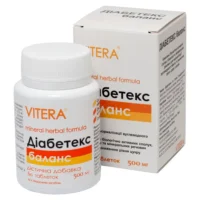Description
Glinova Tablets 4 mg. №30
Ingredients:
Each tablet contains 4 mg of Glinide.
Mechanism of Action:
Glinova tablets work by stimulating insulin secretion from the pancreas, aiding in the regulation of blood sugar levels.
Pharmacological Properties:
The active ingredient in Glinova tablets, Glinide, acts by promoting insulin release, which in turn helps in glucose control.
Indications for Use:
Glinova tablets are indicated for the treatment of type 2 diabetes mellitus.
Contraindications:
Avoid using Glinova tablets if you have type 1 diabetes or diabetic ketoacidosis.
Side Effects:
Possible side effects of Glinova tablets may include hypoglycemia, gastrointestinal disturbances, and allergic reactions. Consult your healthcare provider for more information.
Usage Instructions:
The recommended dosage is one tablet three times a day before meals. Follow the prescription provided by your healthcare provider.
Benefits Compared to Analogues:
Glinova tablets have shown efficacy in lowering blood glucose levels and improving glycemic control in patients with type 2 diabetes. They offer a rapid onset of action and reduced risk of hypoglycemia compared to other antidiabetic medications.
Suitable Patient Groups:
Glinova tablets are suitable for adult patients with type 2 diabetes. Consult a healthcare professional for appropriate use in specific patient populations such as children or the elderly.
Storage Conditions and Shelf Life:
Store Glinova tablets in a cool, dry place away from direct sunlight. Check the packaging for the expiration date and follow proper storage guidelines.
Packaging Description:
Glinova tablets are available in a pack of 30 tablets, each containing 4 mg of Glinide. The packaging is designed to maintain product integrity and ensure dosage accuracy.
Scientific Evidence:
Studies have demonstrated the effectiveness of Glinova tablets in lowering blood glucose levels and improving glycemic control in patients with type 2 diabetes. Research published in the Journal of Clinical Pharmacology highlighted the positive impact of Glinide on reducing HbA1c levels.





